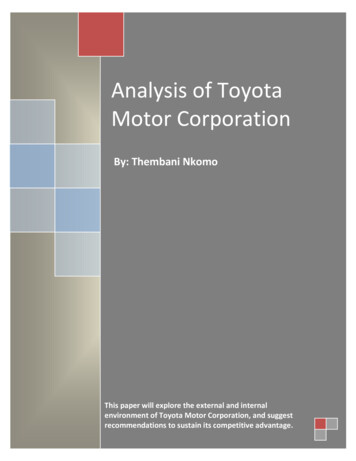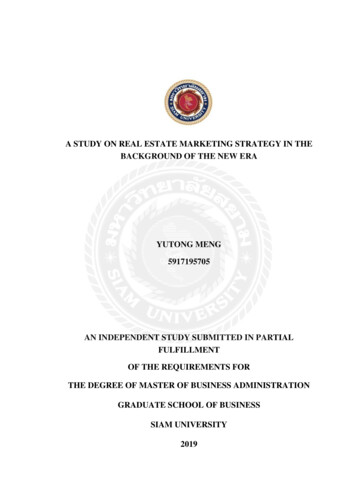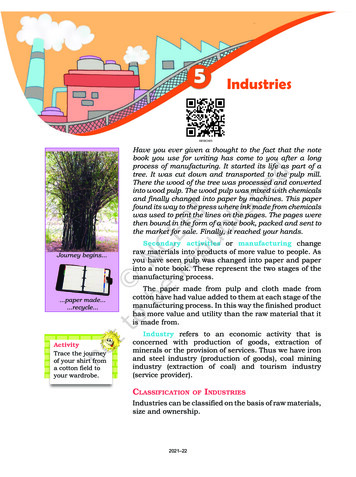
Transcription
Making Industry 4.0 RealThe next wave of economic growth is approaching. Businesses that plan forand act upon rapid changes in technology and processes have much to gain.This guide lights a path to achieving digital transformation in manufacturing,from resolving organisational challenges and cultivating innovation tounleashing human abilities.March 2020
Contents2ContextWhat is Industry 4.0?Present LandscapeSolve Problems, Create Value3344The Digital AdvantageSustainable BenefitsAddressing the ChallengesMaking It Real, Step By Step7789Achieving RealityKey Take-Aways1313References15Connect with UsAbout the authors1616Follow Our Work18Making Industry 4.0 Real
ContextTo succeed in this new era of rapid transformation, manufacturingenterprises must recognize the major changes underway andharness digital technology.What is Industry 4.0?Every era of manufacturing has built on and been characterised by advances in technology.The first industrial revolution arose with the steam-powered factory in the later 1700s. About a centurylater, electricity ushered in the second industrial revolution with mass production and assembly lines. Weare currently straddling two eras: the third industrial revolution, marked by digital communications andautomation, and the fourth industrial revolution, which utilises data and machine learning to lower costsand boost revenue (Marr, 2018). As with prior revolutions, economic growth and prosperity spring fromthis fourth wave of manufacturing.Industry 4.0 is the total integration of manufacturing systems, production processes, digitalcommunications technologies and automated machines. This flexible, intelligent integration provides themeans to leverage data and machine learning, empowering manufacturers to sidestep production issuesand forecast unique opportunities (Jain and Mondal, 2017).Industry 4.0 is an umbrella term for the technology and human-led processes that, when seamlesslycombined, form the digital backbone of smart manufacturing. It encapsulates IT systems, the internet ofthings (IoT) and adaptive manufacturing systems. Essentially, it bridges the physical and digital worlds,facilitating sustainable growth while elevating human capacities and restricting production waste.Industry 4.0 is far more than a technical transformation; it is about improving manufacturing for thebenefit of people and planet.Industry 4.0 or IoT: A ClarificationIt is common to mix up Industry 4.0 with IoT.Bothtermsdescribethetechnologicaladvances underlying the next transformationin manufacturing. Yet each maintains its owncentral tenet: Industry 4.0 refers to optimisingadvanced technologies to simplify productionprocesses and add value, while IoT pertains toconsumersaccessingandusingdigitalproducts and services through a variety ofdevices connected to the internet (TheUnbelievable Machine Company). IoT is onepart of a much bigger Industry 4.0 picture.Making Industry 4.0 Real3
Present LandscapeIndustry 4.0 is based on seamless connections, data-generated insights and workflow automation fromthe factory floor to product delivery and beyond. It is no surprise that manufacturers strive for digitaltransformation—more engaged employees, higher revenues and even greater agility loom over thehorizon (Antonysamy, August 2019). How does the present reality stack up, though?There is a stark divide between the vision of Industry 4.0 and the current industrial landscape. Today’smanufacturing runs on disconnected, dysfunctional processes with little integration between operationalequipment, IT systems and business units. To realize Industry 4.0, manufacturing enterprises must beginthe digital transformation at the foundational level (Cognizant, September 2019).Manufacturers who have already embarked on the road to digital transformation are making impressiveadvances. They are shifting their organisations, changing how people work and deploying technology toachieve value. As an analysis by McKinsey & Company reveals, these early adopters, or “Lighthouses,” areseeing up to 90 percent in productivity spikes. Other major outcomes include slashes in lead times andgreater energy efficiency (Betti et al., 2020).Lighthouses are gaining huge competitive advantages by innovating with suppliers and customers,optimising the entire chain of production rather than just its sole elements. Organisations that have notstarted the journey to transformation still have time to build the momentum needed to catch up—providedthey develop, and scale, with urgency (Betti et al., 2020).It is important to recognize that change is not easy. The first step to becoming a smart, connectedindustrial enterprise is to rally management behind the vision so they can facilitate the reskilling ofemployees and gauge their progress. The next step is to unify, align and integrate operational systems onthe factory floor with IT systems, business processes and organisational models (Cognizant, September2019).Reality in Numbers We recently sponsored a survey of 250 executives in large and mediumprocess and discrete manufacturers across Europe. We learned that: 72 % plan to increase their IoT spending in the next three years. Butmany of these Industry 4.0 implementations are often not automated.Collecting and analysing data still requires a lot of manual work(Milojevic, 2017, p.3). 60% are already involved in Industry 4.0 initiatives, 45% of which areinfluencing business outcomes (Milojevic, 2017, p.8).Solve Problems, Create ValueManufacturers face unprecedented complexities, from intensifying global competition and changingbusiness models to increased regulation and rising customer needs (Deh Hui and Prasad, 2018, p. 4). Atthe same time, these driving forces present limitless opportunities for problem-solving and valuecreation.4Making Industry 4.0 Real
Industry 4.0 dissolves boundaries across the enterprise, opening vast frontiers of innovation. Considerthe role of data in establishing key performance indicators ( KPIs). At present, a lot of potential crossovervalue remains undiscovered and unexplored because the data needed to formulate improvements arestuck in silos.To be clear, there is no shortage of data—manufacturers are swimming in oceans of data. ImplementingIoT solutions and sensor-enabling assets and processes only swell the volume. Graphs, charts and othervisualisations cannot keep up with real-time data.Solving problems and adding value necessitates far more than “getting” data—it is about making dataactionable in order to monetise it (Antonysamy, August 2019). The fundamental question is: How canorganisations gain actionable insights from these massive data flows?Manufacturers should continue applying artificial intelligence (AI) and analytics to what-if scenarios, sincethese data contribute to a more predictive and preventive production system. Using AI technologies suchas machine learning, businesses are already discovering health and usage patterns that translate intopredictive maintenance (if a rotor heats up past a pre-set temperature setting, for example, it can triggerthe algorithm to notify a plant worker or even proactively shut the machine down [Antonysamy, August2019]). The bigger quest, however, is to interpret the data with after-market revenue streams in mind.Hallmarks of Industry 4.0Visibility: Silos come down, freeing up previously hidden value.Transparency: Information is accessible and contextualised in real-time.Predictability: Production is decentralised and functions autonomously.Adaptability: Systems self-diagnose and auto-adjust for preventative maintenance.(Cognizant, 2017).KPIs at a GlanceCorrelating actionable data with KPIs leads to notable increases in business outcomes, as illustrated inthe following chart (World Economic Forum, 2019, p. 15).KPIs improvementsImpact range observedFactory output increase10-200%Productivity increaseOEE increaseProductivity3-50%Quality cost reductionProduct cost reductionEnergy efficiency5-90%5-40%2-50%Inventory reductionAgility5-160%Lead time reduction10-90%10-90%Time to market reduction30-90%Change-over shortening30-70%Lot size reduction50-90%CustomizationMaking Industry 4.0 Real5
How canorganisations gainactionable insightsfrom thesemassive data flows?6Making Industry 4.0 Real
The Digital AdvantageDigitalisation is paving new paths of innovation and sustainability.Yet a successful digital transformation demands more than changesin technology.Sustainable BenefitsIndustry 4.0 revolutionises the manufacturing ecosystem, bringing greater agility through improveddata analyses and digitised processes, not to mention far less production waste. Importantly, it alsoemphasises human agency and skills development. We see three main avenues of sustainableprosperity emerging.1. Adaptive supply chains support unlimited innovation The inventive use of qualitative and qualitative data spawns new business models, along with freshrevenue streams. Digital prototyping allows for low-cost explorations in designing customisedproducts and services that are truly human-centered. Enterprises can make the most of data fromconnected production systems with thorough, precise data analyses. Since the supply chain taps realtime data streams, it is automatically responsive to production flows.Production is planned andscheduled according to the optimal use of resources, eliminating inefficiencies while preventingunnecessary downtime (World Economic Forum, 2019).2. Digital transformation opens up entirely new territory for workers Productivity in Industry 4.0 depends on highlighting human ability. While dull and repetitive tasks areautomated, work that requires ingenuity is performed by people. Upskilling and repurposing staff isthe imperative focus, since technological advances will lead to job changes. Imagine creating a DataDetective role to examine your data streams for ways to increase production uptime. Or maybe youwill need to promote an employee to Machine Teaming Manager, to help workers understand howrobotic/virtual colleagues will change workflows and what machines can actually do for effectivecommunication. (See our 21 Jobs of the Future guide for more inspiration on hiring and trainingemployees in Industry 4.0.)3. Human-machine collaboration accelerates progress in efficiency Expanded capacities in machine learning are distinctive to Industry 4.0. Machines can, for example,detect product flaws. Yet such detections are virtually useless without human intervention—swiftdecisions and actions will need to be taken by people in charge of production processes. The role ofmachines in this case is to alert human managers about any production glitches or breakdowns, whilemanagers step up and quickly determine which actions will avert lost inventory and waste (WorldEconomic Forum, 2019).Making Industry 4.0 Real7
Addressing the ChallengesWhile many enterprise leaders are well aware of the benefits and potential of Industry 4.0, they maystruggle with rolling out their company’s digital transformation. The larger an organisation, themore challenging it can be to get started. Below we identify the most common barriers, and weexplain how manufacturers can move forward.StrategyMost initial deployments of Industry 4.0 will likely be used to reduce costs and improve efficiencies. Thenext wave of manufacturing calls for defining business value, which is pivotal to forging new revenuestreams and customer experiences. A digital-first strategy takes value generation into account. Impactson the business cannot be pushed to the background where they go unmeasured (World EconomicForum, 2019). Flexibility means leaping from waterfall development to agile methodologies.CultureOrganisations that lag in cultivating a digital culture risk stumbling into Industry 4.0 tremendouslyunprepared. Today’s enterprises can be slow-moving, but smart manufacturing calls for constant change.Businesses should create programs that regularly upskill and train employees. Organisations need toenvision how they will make their mark in an ecosystem of ongoing innovation (Jain and Mondal, 2017).LeadershipWith a lack of business and IT leadership dedicated to Industry 4.0 and IoT, formal responsibility for digitaltransformation rarely exists. Diffused accountability is limiting traction and scaling, delaying the time tocapture the value at stake. Moving the ball forward requires building cross-functional leadership teams(e.g. Manufacturing Process, IT/Plant Networking, Controls, Digital, Business and Program Management[Deh Hui and Prasad, 2018, p. 9]).FocusHigh-paced change makes it tough for many organisations to set aside time for concentrated thinking andexperimentation, resulting in “digital distraction.” Initiatives are not aligned with the business strategyand/or applied to areas of maximum value generation. On top of that, there is a tendency to select toolsand solutions that are not reliable or architecturally scalable (Deh Hui and Prasad, 2018, p. 9).InfrastructureMany people in enterprises adhere to traditional IT structures, approaches and methodologies.Additionally, manufacturers grapple with data management. The volume and variability of data—combined with hybrid vendor environments, data security and the convergence of OT and IT solutions—can seem overwhelming. For example, six out of 10 IT executives say that collecting, storing, integratingand analysing real-time data from endpoint devices is a principal barrier to a successful IoT implementation(Cognizant, February 2019).8Making Industry 4.0 Real
Form aContinuously d buildexcitementStimulateandembraceLearn asmuch aspossibleConnectthe dotsMaking It Real, Step By StepHow do we plan? Where do we start evolving our business? How can we influence differentstakeholders? Which partners should we work with? What proofs of concept (PoCs) should weindustrialise? These questions regularly pop up for enterprises as they look toward Industry 4.0.Every manufacturing company will have its own business dynamics, digital maturity and appetite forchange. We recommend taking a planned Agile approach, since agility allows for incremental advancesand helps an organisation identify what works best. An iterative plan with a clear milestone will also giveemployees at every level and function time to adjust to changes brought on by digital solutions. Thefollowing steps are based on numerous best practices, and they should be envisioned as a series ofoverlapping developments rather than as a linear journey.Form a digital transformation team to lead the waySet up a Digital Leadership Lab, a team of front-runners tasked with facilitating transformation. Thenestablish “digital squads” to focus on analytics, cloud, artificial intelligence, process automation. As“doers,” these squads act according to guidance from the Lab. The Lab team is also responsible for sharingproject stories and successes across the organisation. (Learn more about the overall purpose of theDigital Leadership Lab in the “Scale Initiatives” and “Reimagine the Goal” sections below.)Learn as much as possible from an array of digital innovatorsHave the Digital Leadership Lab send the digital squads on a discovery tour, to talk to start-ups and visitinnovation centers and manufacturing peers. The squads should aim to understand how other companiesare succeeding with meeting objectives and observing employee responses to changes. The missiongoes beyond learning to seek and build relations with potential ecosystem partners.Making Industry 4.0 Real9
Connect the dots between collaboration and valueTake an overarching view of the opportunity areas—Industry 4.0, automation, analytics, mobility, etc.Then, plan them conceptually over time. A clear blueprint will include where to pour the foundation andhow to progress with exploring and starting on possibilities. Identify and/or select external partners whocan help you navigate the complexities and interdependencies. Cultivate a vibrant mix of partners savvywith connecting organisational dots, from IT networks and talent development to overall business goals.The ideal partners offer fresh perspectives. Bring these interdisciplinary partners together so they canspot their added value and synergies.Stimulate and embrace experiments within the organisationFind entities within the company that are interested in trying new methods, and enable them to getstarted with Industry 4.0. This step comprises several moving parts:a. Design Thinking – Conduct several workshops using design thinking at digital collaboration studios. Itstarts with the concept of either a problem statement or an opportunity statement. When we hostleadership teams at our Amsterdam Digital Studio, the intent is to identify their biggest problems andtheir real opportunities.b. Prioritisation – The identified opportunities are prioritized based on the leadership team’s willingnessto engage in a project. Prioritisation is not based on major savings but on the notion of the art of thepossible. The team thinks about how technology can help the company and how the company couldshow things that are tangible to their people.c. Execution – Run selected PoCs for system connectivity, data centralization, shop floor dashboards,analytics solutions, automation, etc. The detailed scope, solutions and acceptance criteria for therespective projects were defined and shared with the help of design thinking workshops orrequirement-gathering sessions.d. Inclusion – As new solutions advance, they will inevitably change how people in the manufacturingspace perform their jobs. Automating dull, repetitive jobs is a positive change for employees, butpeople will not automatically adapt. Invite people to participate in reshaping their work by includingstaff in the creative process as well as the implementation of new solutions.e. Change Management – As noted above, job functions evolve in Industry 4.0. Preparing employees forthe future of work requires significant investment in change management. Additionally, we are enteringa new era of collaboration across enterprises. Multiple divisions within an enterprise are cooperating,perhaps in a departure from how they operated before an Industry 4.0 initiative. The governance andthe engagement models between these diverse groups—whether it is operations, field service or IT—should look and feel like one integrated organisation and not separate organisations with differentvalues (Antonysamy, July 2019).Scale initiatives and build excitement around success storiesThe success of Industry 4.0 initiatives relies to a large degree on effective communication and inspiringstorytelling from the Digital Leadership Lab. Along with overseeing the digital squads, this team tracksand broadcasts developmental progress. They also tune into bottom-up initiatives that have not yetinvolved the Lab and make them visible within the whole organisation. The Lab requests support forviable digital projects that are not yet bankrolled and just need company funding to make headway. Thedigital leadership team recognises that financial benefits are not a primary importance at the PoC stage,waiting until the amplification stage to actively integrate and promote initiatives. If the company can reap10Making Industry 4.0 Real
significant savings with multiple applications, the Lab points that out. Importantly, the digital leadershipteam realises that reflecting on failures is just as important as noting successes. Our research showsthat a lack of strong goals and a clear, long-term governance and ownership model lead to projectfailure. The project statistics from our research illustrate how failure occurs: just 33 percent sprung froma strong goal; a lack of robust data hampered 57 percent of projects; managers could explain the longterm ownership in only 29 percent of initiatives. As Rouzbeh Amini writes in “Three Reasons That IndustryPoCs Do Not Scale,” less than 40 percent of Industry 4.0 projects will scale without extensive changes toa program’s construct (Amini, 2019).Continuously rethink the challenges, successes, technology and partnersIndustry 4.0 requires continuously rethinking challenges, successes, technologies and partners.Technology will take enterprises to places they probably cannot comprehend right now. Stoking the firesof imagination is a main task for the Digital Leadership Lab—there can be no stagnation. What metricsshould help a company experiment and industrialise? Which metrics should gauge the success of projectsin the larger organisation? The first group of metrics is based on proven functionality—whether the projector PoC achieved success. If the goal is to automate something, for example, simply measure whether itwas automated. The second group of metrics is based on the spread and proliferation of projects. Theseare softer metrics: the number of mobile applications, connected systems, applications in the cloud, theextent of the data analysed and so on. Financial goals do not factor into success metrics at the initial stageof projects.Quick TakeIndustry 4.0 Case StudiesGrundfos: As one of the world’s largest pump and water management companies, Grundfoshas installations that span the globe. Thus, the company cannot always source a local Grundfosexpert to fix a malfunctioning machine on site. When the enterprise sought a way for nontechnicians to repair broken equipment, Cognizant developed a digital solution: an AIinformed, hologram-like display that augments reality and allows a non-specialist to performmaintenance on complex systems. In working closely with Grundfos, we started from a humanperspective before combining several technologies to solve the challenge.A global consumer care products player: With worldwide production facilities for theirconsumer care products, this enterprise intended to drive their Industry 4.0 roadmap withConnected Factory and Visual Factory initiatives. Enhancing the visibility on the readiness ofrequired parts for planned production runs was a major theme in the Visual Factory track. Theenterprise was looking for a means to visualize data from various systems, so that a productionline manager could prioritise production runs based on parts availability status. Cognizantapplied a human-centric design approach to understand the main pain points. Then wecollaborated with the production line team on developing an integrated solution, whichprovided a timeline and chain visualisation to enable early decision-making and save time onthe shop floor.Making Industry 4.0 Real11
Industry 4.0is a marathon,not a sprint.12Making Industry 4.0 Real
Achieving RealityMaking transformation real requires action. This section maps outthe journey to Industry 4.0, from taking the first step to thriving in adigital paradigm.Key Take-AwaysHere is a condensed overview of the main points and most vital calls to action.Cultivate transformation and build your ecosystemCreate a Digital Leadership Lab, a team to facilitate transformation and amplify initiatives acrossthe organisation. Then form your digital squads, agile groups that gather knowledge and act onguidance from the Lab. Select diverse digital transformation partners. Collaborate withmanagement consulting firms, software vendors, IT services firms and start-ups. Seek out a fewbig partners with 4.0 capabilities who offer trust and fresh thinking—they will represent thetransformation core. Partner with niche firms too, since they can bring a short-term competitiveadvantage through their cutting-edge technologies and solutions.Scale your PoCs to generate incredible valuePoCs should either solve a pressing problem or cash in on an opportunity. Identify potentialPoCs through design thinking workshops with stakeholders. Any PoC should be easy toimplement and support scaling for a quick value capture. Frame the initiative as a world ofpossibilities for the organisation.Measure beyond the dollar—consider how changes affect employeesOverall, broad financial goals matter. But too much focus on savings at the outset will causedelays. Use realistic metrics that encourage experimentation and usage in the initial stages,then turn to other practical metrics for later stages. New ways of working, along with innovationsin technology and data, will naturally produce resistance. As the adoption of PoCs/solutions iscrucial, it should benefit the work of humans. Be sure to include softer metrics like job satisfaction and upskilling goals.Envision the long-term as you persistently evolveThe successful implementation of Industry 4.0 requires buy-in from various stakeholders. It willrequire extensive communication, meetings with stakeholders and training programs.Showcase the successes of early PoCs to maintain organisational motivation. Industry 4.0 is amarathon, not a sprint. Further advances in technologies, methodologies and standards arebound to emerge. Given the pace of development in Industry 4.0, enterprises cannot afford tostick with legacy technologies and outdated service providers. Flexible enterprises will adoptand implement developments as they arise, guaranteeing sustainability.Making Industry 4.0 Real13
14Making Industry 4.0 Real
ReferencesAmini, Rouzbeh. “Three Reasons That Industry 4.0 Initiatives Do Not Scale,” Cognizant Perspectives, 11September 2019, nysamy, Frank. “Need for Change Management in the Digital Era,” 11 July 2019, Cognizant video,https://www.youtube.com/watch?v nBdMHvwDojU&feature youtu.be.Antonysamy, Frank. “Four Keys to Success With Industry 4.0.” Digitally Cognizant, 19 August success-with-industry-4-0-codex4836.Betti, F., de Boer, E., & Giraud, Y. “Industry’s Fast-Mover Advantage: Enterprise Value From DigitalFactories,” McKinsey & Company, January 2020, nterprise-value-from-digital-factories.Cognizant. “Designing Manufacturing’s Digital Future,” PowerPoint presentation, April 2017: 7.Cognizant. “The Five Essential IoT Requirements and How to Achieve Them,” February m-codex4241.pdf.Cognizant. “Industry 4.0: Moving From Vision to Reality,” 10 September 2019, 0-moving-from-vision-to-reality.Deh Hui, C. & Prasad, S. “Navigating the Shift to Industry 4.0,” PowerPoint presentation by Cognizant andMicrosoft, 2018: 4.Jain, P. & Mondal, T. “HfS Blueprint Guide: Industry 4.0 Services,” Horses for Sources, April 2017: 2.Marr, B. “What is Industry 4.0? Here’s A Super Easy Explanation for Anyone,” Forbes, 2 September anation-for-anyone/#2c08ccf39788.Milojevic, M. “Digital Industrial Transformation with the Internet of Things,” trend study by Cognizant andCXP, April 2017: 3.The Unbelievable Machine Company. “Defining Digitalization: Industry 4.0 or Internet of of-things.World Economic Forum. “Fourth Industrial Revolution: Beacons of Technology and Innovation inManufacturing,” white paper, January 2019: 15.Making Industry 4.0 Real15
Connect with UsWe can support your organisation in evolving its people, talent andknow-how for digital transformation. Tap our expertise on bringingIndustry 4.0 initiatives up to reality.About the authorsDo you have questions about planning for or implementing Industry 4.0? Feel free to share your questionsand concerns with our digital transformation experts, Corwin van Heteren and Rouzbeh Amini.Corwin van Heteren is Digital Partner within CognizantDigital Business. He has more than 20 years of experience inproduct and process innovation within diverse industries,from Healthcare and Automotive to Manufacturing andLogistics. He supports clients in making digital technologies acornerstone of their customer and employee strategies. As astrong believer in human-centric approaches, Corwin guidesclients on understanding their Why before putting the Whatand How into play. He facilitates learning from failure,delivering winning solutions that shape business processesand customer service.Email Corwin: Corwin.vanHeteren@cognizant.comDr. Rouzbeh Amini is a Senior Director and Principal Architectin Cognizant Benelux. He earned his PhD in AerospaceEngineering from Delft University of Technology, Netherlands.Rouzbeh has led multiple Industry 4.0 initiatives acrossEurope, and he advises manufacturing executives on digitaltransformation, from data strategy and industrial innovationsto design and evaluation of R&D roadmaps. His areas ofexpertise cover a vast range: cyber physical systems, IoT, datascience, AI, robotics, wireless systems, mission criticalsystems, advanced sensing and automation.Email Rouzbeh: Rouzbeh.Amini@cognizant.comThe authors thank Yoana Rotsaert and Kimberlyn David for their editorial support.16Making Industry 4.0 Real
Making Industry 4.0 Real17
Follow Our WorkWe regularly share insights on how businesses across industries canrealize new levels of agility, security and efficiency. Explore our latestresearch and digitally.cognizant.com18Making Industry 4.0 Real
Making Industry 4.0 Real19
About CognizantCognizant (Nasdaq-100: CTSH) is one of the world’s leading professional services companies, transformingclients’ business, operating and technology models for the digital era. Our unique industry-based,consultative appr
Industry 4.0 or IoT: A Clarification It is common to mix up Industry 4.0 with IoT. Both terms describe the technological advances underlying the next transformation in manufacturing. Yet each maintains its own central tenet: Industry 4.0 refers to optimising advanced technologies to simplify










